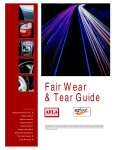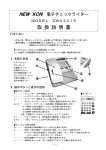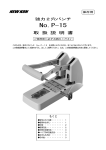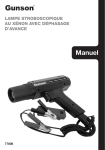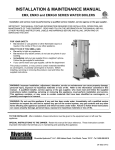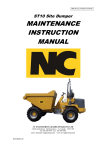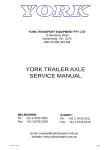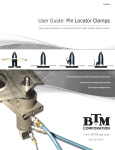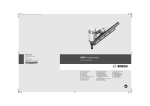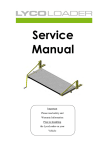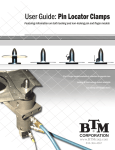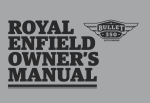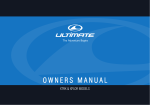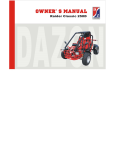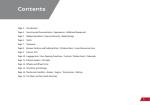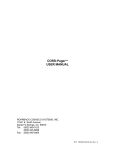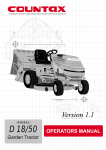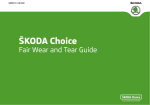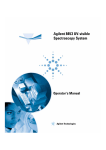Download View PDF - York Transport Equipment
Transcript
Our products are built to high standards and are engineered to give years of dependable service, but regular attention is recommended for continuous efficient running. Maintenance procedures are carefully set out in this booklet to enable the operator to obtain the most satisfactory performance from the equipment and operators are expected to perform these recommended maintenance procedures as a condition of our warranty. TRAILER AXLE When renewing parts, use only genuine parts, as they are correctly designed and manufactured to exacting standards of quality control to ensure optimum performance. When ordering parts, always quote the component or equipment serial number and type designation. Illustrated parts lists are available on request. PREVENTIVE MAINTENANCE SCHEDULE (Bearing lubricantsTimken 270 or MOBIL grease HP222 or equivalent) The following schedule refers to axles fitted to any make trailer, for trailers running under normal conditions. During servicing, replace defective items with genuine parts. For details on trailer maintenance, refer to trailer manufacturer. First 500 km Check recommended torque settings, dry threads. Note: The use of power tools for torque settings is not recommended. 1 ft/1 b = 1.36 Nm W H E E L N U T S ( o n d e l i v e r y o r a f t e r w h e e l c h a n g e , check and re-torque the wheel nut monthly during operation). ISO M22 ISO M24 BSF 7/8" DIN M22 Japanese M20 Japanese M24 3 5 Spoke Hubs /4" UNC 6 Spoke Hubs M18 6 Spoke Hubs M20 CAMSHAFT BRACKET SETSCREWS M12 M10 760/850 840/930 760/850 760/850 500/600 670/770 270/300 270/300 Nm Nm Nm Nm Nm Nm Nm Nm 320/360 Nm 90/100 Nm 30/35 Nm Lubricate camshaft grease nipples using Lithium soap based grease E.P.2. First 5,000 km Full wheel bearing adjustment (see Page 9 for procedure). Every 5,000 km Check and adjust brakes and check brake linings for wear. Every 25,000 km Lubricate slack adjuster and camshaft using EP2 grease or equivalent (Do not over grease). Rotate wheels and check wheel bearings with lever to as certain if there is excessive bearing movement. Examine and re-adjust if found loose. Every 100,000 km or Every 2 Years WHEEL MOUNT FITTING Every 300,000 km or Every 2 Years Remove, wash and inspect wheel bearings, replace if necessary. When re-assembling, bearings must be properly lubricated and adjusted to our specifications. IMPORTANT NOTE: If the operating service conditions are severe, this procedure may be required at more frequent intervals. Remove, wash and inspect wheel bearings, replace if necessary. When re-assembling, bearings must be properly lubricated and adjusted to our specifications. IMPORTANT NOTE: If the operating service conditions are severe, this procedure may be required at more frequent intervals. It is important to ensure that nuts and collars match the wheel to be fitted, i.e. ISO nut with integral washer should be matched with ISO wheel rim with straight hole and located on hub spigot; DIN nut and collar should be matched with R18 spherical seating; BSF conical nut and collars should be matched with U.K. standard wheel with conical seating; JAP globe nut should fit with R22.2 spherical seat. This Wheel mounting fitting must not be interchanged or mixed in any combination Operators should establish a schedule for periodic adjustment, clearing, inspection and lubrication of brake equipment; such a schedule will eliminate trouble before it develops. The following points should be observed to maintain the original standard. GENERAL SERVICE REQUIREMENT a) Brakes should be adjusted as frequently as required to maintain the original standard for safety. Uniform lining clearance and correct travel of levers must be maintained. b) At regular intervals remove the brake drums and check the lining for wear; the linings must not be allowed to wear down to the rivets. When fitting new brake shoes or after relining, always fit new return springs. c) Brakes should be cleaned, inspected, lubricated and adjusted each time the hubs are removed. During every brake relining, inspect the following parts for wear, deterioration, cracks or other damage: a) Wheel stud and collar. b) Hub and drum. c) Bearing. d) Hub seals: It is recommended that new seals be fitted at this time. e) Brake cam roller and roller retaining springs. f) Brake anchor pin and bushes. g) Brake shoe and the hole tor anchor pin. Prior to re-assembly, the following pads should be lightly coated with Lithium soap based grease E P.2. a) Brake cam roller and journals, b) Brake shoe anchor pin hole and bush surface. c) Bore of camshaft nylon bush. Greasing should be continued until the clean lubricant is forced out of the fittings, showing that fresh clean grease has forced out the dirty grease in all the working parts. The dirty grease should be removed. IMPORTANT: Where assemblies are fitted with a seal, greasing at high pressure may damage the seals; in such cases, care must be taken not to lubricate excessively. The use of good quality oils and greases is most strongly recommended. Poor quality, low priced lubricant may cause damage, as very often it lacks essential qualities. NOTE:1)All removed parts must be kept together in good clean condition ready for subsequent refitting after passing examination. HUB SERVICING 2)For workshop safety when jacking up trailers, always use two jacks positioned as close to spring seat center as possible. 3)When ordering spares, it is important to quote axle type number which is stamped on the axle serial plate. (If plate is missing, serial number is stamped onto beam at central point where the plate was fitted). Removal of Hub and Drum EXAMPLE OF AXLE SPARE PART LISTIG Spoked Wheels Hubs Servicing (a) Remove set screws securing hub cap and gasket (b) Remove hub bearing locknuts and washer (c) Ensure brakes are slackened off (d) Withdraw hub and drum assembly. Ensure that outer bearing does not fall out of hub (e) Remove inner and outer bearing assemblies Hub and bearings should be thoroughly cleaned, examined then repacked with a recommended lubricant. A spoke wheel hub replaces the standard hub on some model of axles. A five spoke hub (Alternate 6,5 spoke or 3 spoke) is secured to the outside face of the brake drum by bolts and nuts. Thoroughly clean all parts and examine for wear or damage. Ensure the machined ends of the spokes are not burred. Any burrs should be removed by light filing. IMPORTANT: Do not paint the machined spoke ends. Paint can cause misalignment of the rims. Refitting hub and drum is in reverse order to removal. Ensure that procedure for bearing adjustment is strictly adhered to. Spoke Hub Torque Settings(Fig.6) Clamp bolt nut - 6 spoke hub M18 270/300 Nm -5 spoke hub ¾” UNC 270/300 Nm Hu b to d ru m f ixin g n ut s - 6 spo ke h u b M 2 0 x 2 . 5 - 3 0 0 / 3 4 0 N m - 5 spoke hub 3 /4" UNC –300/340 Nm - The torque figures given are the recommended lower and higher figures. Tightening nuts more than the higher figure is not recommended. When tightening clamp bolt nuts on spoke hub axles. TIGHTEN CROSSWISE, Tighten each nut lightly and turn clock wise or anti-clock wise and repeat the operation until the nuts are tight. Check torque setting of clamp bolt nuts after 80 km and tighten if necessary. The following servicing procedure is recommended.Carefully protect bearings from dirt and moisture whilst they are out of their housings. It is advisable to wash them thoroughly immediately after removal, by the following procedure:(a) Bearings Servicing (b) Immerse in a washing fluid such as clean white spirit or good quality paraffin (DO NOT USE PETROL). The washing fluid must not attack the bearing components. After soaking, swirl each separate bearing around in the fluid, using a basket or other container if convenient. A clean fibre brush may be used, care being taken that no bristles lodge In the bearing. Occasional slow oscillation of the bearing rings will help dislodge dried out grease and other matter. Never spin a dry bearing which could cause the rollers to skid, thus damaging the highly finished internal surfaces of the bearing. When clean, thoroughly drain and dry in an oven or on a hot plate; a temperature of 65-80`C should be adequate. After checking for signs of wear or damage, lubricate the bearing immediately and re-fit. Alternatively, completely coat all parts with a rust preventative oil, working it well into the internal parts of the bearing. Then wrap in greaseproof paper and box until required for re-fitting. IDENTIFICATION OF WEAR OR DAMAGE 1. Dull appearance, roughness or pitting of rollers and raceways. Abrasive dirt causing premature bearing failure. 2. Excessive wear on large end of roller. Over tightening. 3. Flaking on small end or rollers, cup and cone rolling surfaces. Loose adjustment. 4. Fractures or fine hairline cracks across the cup or cone surfaces Forcing a cone assembly on an oversize spindle, or forcing a cone assembly on to the spindle out of square; or by forcing a cup into a warped hub bore. 5. Series of indentations or lines on the raceways 6. Corrosion Bearing Failure POSSIBLE CAUSE 7. Blue or blue/brown discoloration Improper mounting or sudden excessive shock loads. Ingr ess of wate r o r us e of i ncorr ect lubricant. Check grease/oil seals. Indicate overheating. Possible causes are over tightening, lack of lubricant, overfill of grease or ingress of foreign material. Always renew any bearing which does not, without any doubt or hesitation, pass inspection. The danger and cost of bearing failure in service is many times the replacement value of any bearing. To inspect the bearing cone, hold it up so that the bearing is between the eye and light. Look between the rollers in order to see the raceway or outer surface. Hold the cage and slowly rotate the cone to check for wear or damage over the entire surface. Both inner and outer bearing cups must be tight press fit into the hub, Any sign of looseness means replacement of hub. The outer bearing cones should be a sliding fit on the spindle, they should not be loose enough to spin. Assembling Hub and Drum components 1. If hub and drum have been removed from axle, cleaned and greased, refit components in reverse order to removal. 2. With hub in upright position, fit both bearing cups firmly onto hub bearing shoulders. Thoroughly coat both cups with Lithium soap based grease. Take care to ensure cups are fitted squarely. 3a. Fit inner bearing cone to hub squarely. (for 2000, 2600, 2700, 2950 & 5000 Axle Series bearing hub) 3b. Fit hub seal onto spindle shoulder with wiping edge or lip facing towards the bearing, using installing tool. (for all TQ type 6000 & 8000 Axle Series bearing hub) 4a. Fit hub seal to hub with wiping edge or lip facing towards the bearing, using installing tool. (for all TQ type 6000 & 8000 Axle Series bearing hub) 4b. Fit inner bearing cone onto spindle. (for 2000, 2600, 2700 , 2950 &5000 Axle Series bearing hub) 5. Carefully feed hub and drum assembly onto the axle at a slight angle and with a slight rotary movement to seat the grease seal. Check that grease seal is in place and undamaged. 6. Fit outer bearing cone. 7. Fit bearing adjuster nut and adjust bearing end float. 8. Fit brake drum dust covers. 9. Fit grease packed hub cap and seal. ASSEMBLY OF HUB AND DRUM COMPONENTS IN PICTURES TQ BEARINGS Assembling Hub and Drum components SLIDING OUTER BEARING ONTO BEARING Assembling Hub and Drum components FITTING THRUST WASHER INTO SPINDLE Assembling Hub and Drum components TIGHTE THE SPIDLE ADJUSTABLE UT OTO SPIDLE (UT WITH A PI) PRELIMIARY TIGHTE THE UT WITH WRECH AD AT THE SAME TIME ROTATE THE HUB AD DRUM ASSEMBLY CLOCKWISE AD ATICLOCKWISE Assembling Hub and Drum components FINAL TIGHTEN THE HUB AND DRUM ASSEMBLY WITH TORQUE WRENCH (CONTINUE TURNING THE HUB & DRUM ASSEMBLY) PRE TORQUE TO 270 Nm – RE-TORQUE TO 200Nm. FINAL TIGHTENING MUST BE DONE USING TORQUE WRENCH SET. Assembling Hub and Drum components • PLACE WRENCH ONTO ADJUSTABLE NUT • PLACE LOCK WASHER ONTO SPINDLE (ALIGN WITH KEYWAY) • LOCATE PIN POSITION WITH REFERENCE TO LOCK WASHER; SLACKEN THE ADJUSTABLE NUT BY 6 HOLES Assembling Hub and Drum components INSERT TAB LOCK WASHER ONTO SPINDLE TIGHTEN LOCK NUT WITH WRENCH AND FINAL TIGHTEN WITH TORQUE WRENCH SET TO 340/400Nm Assembling Hub and Drum components PLACE MAGNETIC STAND AT END OF SPINDLE ADJUST DIAL TO CONTACT PERPENDICULAR TO HUB FACE AND KNOCK BACK THE HUB AND DRUM ASEMBLY TO FRONT AND SET DIAL TO ZERO USE A FLAT BAR TO PIVOT ON LOCK WASHER AND PUSH BACK TAKE THE END FLOAT READING (MUST BE WITHIN 0.08-0.20MM) READJUST END FLOAT BY LOOSENING/TIGHTENING ONE HOLE OF ADJUSTMENT NUT Assembling Hub and Drum components AFTER END FLOAT IS ACHIEVED BEND THE LIP WITH A BAR OR SCREW DRIVER. GREASE ONE ROUND OF GREASE ON OUTER EDGE OF BEARING CONE WHEEL BEARING ADJUSTMENT – 2.5 INCH SPINDLE Assembling Hub and Drum components 1. Ensure hub rotates freely 2. Rotate the hub in both direction and tighten spindle nut 3. Continue the process until binding is felt and torque of 200Nm is reached 4. Using clock washer as a guide slacken back 6 holes 5. Refit the lock washer matching hole into spindle nut FULL BEARING ADJUSTMENT – 3.5 INCH CASTELLATED NUT 1. Rotate hub in both directions 2. Tighten the adjusting nut until torque setting of 340/380 Nm is reached. 3. Insert pin and check end play 4. After end float is achieved bend pin Assembling Hub and Drum components 1. Ensure hub rotates freely 2. Rotate hub in both directions and at same time tighten the castle nut 3. Tighten until binding is felt. 4. Torque the nut to 340-380 Nm 5. Slacken the nut until slot aligned or nearest pin hole A aligns with pin hole B 6. Insert split pin 7. Check bearing end play to fall within 0.025-0.13 mm 8. Readjust if end play is out of range We recommend that all axles should have the wheel bearings adjusted initially after the first 5,000 km and then at 100,000 km or 2 years intervals. The recommended wheel bearing adjustment procedure is as follows:- Wheel Bearing Adjustment (Fig.7) 1) Raise the axle by using 2 jacks placed as close to the spring seat as possible. Ensure that the brakes are slackened off and not binding on the drum. Remove hubcap, slacken and remove the outer locknut, lock-tab washer and lock washer. 2) Rotate the hub in both directions and tighten the inner adjusting nut at the same time. Continue until a binding is felt and a torque setting of 270 Nm is reached .Release and toque again to 200Nm 3) Using the lock washer as a guide, slacken the inner adjusting nut by 6 holes and re-fit the lock washer. 4) Fit the lock-tab washer, taking care that the adjustment is not disturbed and fit and tighten the outer locknut to 340-400 Nm. 5) Check that the hub and drum rotates freely. Use a dial indicator to make the final check of the end play. (only for hub fit with TN,TM 2000, 2700 & 2950and 5000 Axle Series bearing) The recommended end play is between 0.08mm to 0.2mm. IMPORTANT NOTE: If not, re-adjust. 6) Bend the tabs on the lock-tab washer over to prevent the outer locknut coming loose in service READING OF THE DIAL INDICATOR SHOULD BETWEEN 0.08 TO 0.20 mm Wheel Collar and Wheel Rim Prior to assembly, check and replace any wheel studs which are broken or show the slightest sign of wear and are thread stripped. The possible causes of stud failure are: a. The nut torque is insufficient. When the torque is insufficient, the nuts will loosen themselves gradually during operation, the whole wheel assembly gets loosened, eventually almost all the wheel studs will suddenly shear off. It often happens after initial operation or after tyre change. Wheel Stud Replacement b. Overloading. Overloading will also cause the wheel nuts to become loose and the studs shear off as the normal specified torque is not enough for excessive axle load. Higher axle load needs stronger wheel studs and higher nut torque. c. Excessive torque. Excessive torque will either strip the thread or overstress and break the wheel stud. Excessive torque often happens when power tools (i.e. air wrench) are used. A typical stud breakage caused by overloading or excessive torque is that one or two studs break first while wheel studs still remain tight temporarily. IMPORTANT NOTES: 1) Proper nut torque is important. Use a torque wrench to assure proper torque. Insufficient torque can cause stud breakage or damage the wheel rim stud hole. Over torque can stress the stud, strip the thread and lead to stud breakage. Incorrect torque may result in stud breakage and loose wheels, and can cause accidents. 2) If air wrenches are used, they must be periodically calibrated in both directions for proper torque output. Use a hand torque wrench to check the air wrench output. If the output is not correct, take the necessary steps to adjust output. After the first 500-750 Km of service, the nut should be re-tightened to the specified torque and checked monthly during operation. The driver should check daily if there is any stud breakage. It is dangerous to operate without changing broken studs, as the studs on each side of the broken stud will take extra stress and break soon. Eventually it will lead to the breakage of all the wheel studs. RECOMMENDED PROCEDURE FOR REPLACING STUDS: • When a broken stud is replaced, the stud on each side of it should also be replaced. If more than 2 studs are broken, replace all studs (Fig. 8) • Use correct studs • The stud must be firmly driven into place, taking care to ensure that stud remains square with the hub surface and seats flat against inside face of brake drum In replacing BSF and JAP stud, remember that right-hand studs go on the right hand side of the vehicle and left-hand studs on the left-hand side when facing forward Fig 8 It is important to ensure that wheel nuts and collars match the wheel to be fitted. They must not be interchanged or mixed in any combination. Examine stud holes in wheels for wear on conical (or spherical) seat, examine the collars for damage. Damaged, worn-out collars as well as enlarged conical (or spherical) seats of stud hole in wheel rim will cause looseness of the wheel nut, which will eventually break the wheel studs. For BSF fitting, wheel rim should seat on the conical collar instead of on the hub surface. There should be a 0.38mm min. gap (measured by feeler gauge) between wheel rim and hub surface with all nuts tightened to recommended torque settings. Where wheel collars and conical (or spherical) seat do not pass examination, replace collars and wheel rim. BSF COLLAR REPLACEMENT PROCEDURE: (a) Jack up trailer and support trailer weight on fixed trestle supports. (b) Remove road wheels. (c) Remove hub and drum assembly ensuring that outer bearing does not fall out of hub. (d) Press out wheel studs using a hydraulic press (recommended method) or alternatively drive out using a soft metal hollow drift. (e) Drive out wheel collars of 23 mm diameter. using a sharp edged steel drift (f) Ensure holes in hub are in new collars using a collar of matching type is face. Ensure collars are and fully seated. clean and undamaged. Press hydraulic press ensuring that fitted, i.e. conical or radiuses pressed or driven in squarely The bearing cones and rollers should not be greased but dipped in SAE 90 grade oil after inspection and prior to fitting. The hub should be filled with SAE 90 grade oil to level indicated on hub cap, after completed assembly to axle spindle. Hub Seals Lubrication Procedure – Oil filled hub a) Clean Hub mounting face of hub and apply a light coat of non-setting sealing compound b) Position the gasket on the hub and apply a light coat of sealant to the outer surface of gasket c) Fit hub cap and secure with cheese head screws and fibre washers d) Remove plug from hub cap and fill with SAE 90 oil to lever marked on cap. Allow time for oil to fill cavities, recheck level and top up if necessary Greased Hubs a) Inspect grease/oil seal and replace if necessary b) Inspect bearings for wear or damage and repack with grease thoroughly working grease between rollers Brake Servicing – “S” Cam Operated Brakes Lubrication Procedure – Greased hubs c) Lightly smear the hub between the two bearing cups with Lithium soap based grease. MOBIL HP222 or TIMKEN Grease No. d) Lightly grease spindle e) Ensure there is ample grease between inner bearing and grease seal f) Ensure there is ample grease between front bearing and hub cap g) Renew hub cap seal or gasket if necessary h) Do not pack grease within hub tightly i) 1.4 kg of grease has to be applied per axle for TN/ TM bearings as per the procedure explained. For TQ bearings 1.8 kg of grease has to be applied As a rule, seals should be renewed each time they are removed from their housings. It is false economy to refit a worn seal, or one which has deteriorated in any way. INSPECTION After cleaning with light oil, make the following checks and discard, without hesitation those which do not pass on each count:1. Check fit in housing 2. Check expander spring - where applicable 3. Check that seal is not worn, cut, charred or hardened 4. Check metal shells or retainers - where applicable, for wear or distortion Note: It is inadvisable to allow any seal to go through a degreasing plant using either tri-chlorethylene or petrol. Use only light lubricating oil. Brake Servicing – “S” Cam Operated Brakes This is a leading and trailing shoe type of brake, as used on the larger commercial vehicles in conjunction with air brake equipment. The shoes are fabricated steel and are mounted on individual anchor pins on welded anchor brackets. The air chambers are mounted on brackets welded to the axle beam. The inner camshaft support assembly is mounted in a spherical nylon bearing to guarantee alignment and allow free operation of the shaft. The brake shoes are actuated by a constant lift "S" type cam forging, pressure being applied to the shoes through cam rollers which are retained by spring clips. Brake linings are tapered section to give maximum contact area with the brake drum and are fitted in pairs to each shoe. Remove dust covers. Remove anchor locking pin or circlips. Remove shoe anchor pins and bushes. Lift shoes over anchor bracket. This movement releases tension on shoe springs. Unhook springs. Remove spring bars from the twin webs of the shoes. Disengage the cam roller retainer and remove cam rollers. Remove shoes. Remove the circlip and washers from camshaft adjacent to the slack adjuster. Remove slack adjuster. Unclip the second circlip situated adjacent to the camshaft bracket. the camshaft whilst washers sliding the circlip and washer' down the camshaft. Remove the various from the camshaft. Remove nylon bush camshaft bracket. Unscrew securing nuts and bolts and remove spherical nylon bearing and brackets. Remove rubber sealing rings from spherical bearing. In all cases where parts show signs of excessive wear, they must be replaced. Brake Dismantling Dismantling Brake and Assembly Assembly and Brake Linings must not be allowed to wear down to the rivets. Replacement brake Linings are marked "cam' and "anchor'. The anchor lining has a greater taper and should be fitted at the "anchor" end of the brake shoe; When fitting new brake shoes, always fit new shoe return springs. Lightly lubricate the following parts with grease:(a) Brake anchor bracket bore or bush bores (if fitted). (b) (c) (d) (e) Brake anchor pivot pin. Camshaft bearings. Cam rollers. Camshaft bearing surfaces. Check direction of camshaft rotation to ensure correct operation and freedom of movement. BRAKE ASSEMBLY IN PICTURES SHOWN. Brake Dismantling and Assembly Fit camshaft through camshaft bush. Insert O ring, washer circlip and dust seal. Position Cam Roller onto the brake Shoe. Brake Dismantling and Assembly Using a Flat bar press down the roller retainer. Fit the other retainer in similar manner in opposite direction. Finished position of Roller retainer. Fit Spring return spring onto brake shoe. Brake Dismantling and Assembly Align the brake shoe and spider anchor pin hole as shown in the picture above. Insert brake return spring onto the assembled onto pin return spring. Brake Dismantling and Assembly Using a circlip plier insert the circlips onto the anchor pins. Ensure the circlip is fully seated in the groove. If the circlip is not fully seated in the groove it may result in total loss of braking. Brake Adjustment "S" type cam brakes are adjusted by means of slack adjusters fitted to the camshaft. a) With brakes released adjust slack adjuster until shoes make contact with drum. b) Adjust slack adjusters to obtain free running clearance and check that the angle formed by the slack adjuster arm and the brake chamber push rod is greater than 90 degrees both with brakes released and applied. When lining wear causes travel, increase to the stroke limits listed below, readjust:Chamber Type Stroke Limits Auto Slack Adjuster Servicing Type 12 38 mm Type 16 44 mm Type 20 76 mm Type 24 76 mm Type 30 76 mm AUTO SLACK ADJUSTER SERVICING ILLUSTRATION Part os : 73005/5- 37 Spline & 730104/5 – 10 Spline Diagram shows the locking sleeve in its disengaged position. Be sure this is held in, disengaging the adjusting screw when making adjustments. Brake Drums Replacing Brake Linings Diagram shows the locking sleeve in its engaged position. It is important that this sleeve is returned to this locked position, engaging the hexagon head of the adjusting screw following adjustment. Re-boring or skimming is not recommended. It weakens the drum and the increased internal diameter permits the cam to rotate too far. This can result in sticking cams or "cam roll-over". Both can be dangerous for obvious reasons and difficulty may be experienced in removing the brake drums. Furthermore, if relined shoes are fitted, their contour will not conform to the shape of the skimmed drum, resulting in poor brakes through reduced contact area. To ease brake Inspection, dust covers are fitted as two halves. A rubber plugged aperture provides for quick brake lining Inspection and inner camshaft bearing grease nipple access. Ensure lining and shoe contact faces are clean prior to fitting and that shoes are not distorted or damaged. Rivets must be of the correct diameter, head size and type. a) Firmly clamp lining to shoe ensuring rivet holes are aligned. b) Insert rivet and drift fully home taking care not to damage lining c) Spread rivet shank using tubular rivet dolly of correct size ensuring rivet head remains firmly seated and shoe and lining remain firmly clamped. d) Check liner and shoe contact using 0.2 mm feeler gauge AXLE ALIGNMENT Incentive To obtain the maximum mileage from tyres and eliminate side tracking and poor vehicle control, tractor and trailer axles must be maintained parallel to each other. Various adjustment methods are employed, the most popular being slipper type with either fixed radius rods (torque arm) or adjustable rods (torque arm) fitted beneath the springs. Suspension mounting brackets are located precisely on the main rails or frame, in relation to the King Pin, and this accuracy must be maintained if replacing parts. A 3 mm deviation must be considered as the maximum tolerance. Preparation Apparent axle misalignment is sometimes due to the trailer standing on uneven ground, causing a self steering effect or, alternatively, the trailer may be at rest immediately following a turn. This temporary condition would be corrected on moving off. We suggest that the above factors are noted before adjusting axle alignment. Shunt the trailer forward and backward a little so that the unit comes to rest with the suspension leveled and the brakes in the "off" position. Wind down the landing gear and uncouple the tractor from the trailer, Always examine mechanical parts or replace worn parts prior to making an axle alignment check, i.e. radius rod b ushes, rubber and steel springs and spring "U" bolts. Check axle alignment by measuring from the king pin centre to each end centre of the trailer axle (Fig. 17). The distances (A) and (B) must be within 2 mm from each other, (A,B±2mm) On multi-axle vehicles, the trailer rear axles should be parallel to the trailer leading axle, (C) being within 1 mm. (C1=C2±1mm) Where obstructions prevent the tape measure being in a straight line, it will be necessary to transfer the measurements to floor level using two plumb lines. Recheck all measurements after adjustment. Checking To check for matched height, park loaded trailer on a level surface and measure from ground (or wheel hubs) to the underside of each side rail. These measurements should be equal, but a discrepancy of up 12.0 mm is acceptable Should the difference be greater than this, a weak spring is the possible cause. In such cases, springs should be replaced by new components, in order to obtain matched heights. AXLE FAULT DIAGNOSIS CHART FAULT Damaged Wheel Studs POSSIBLE CAUSE 1. Wheel nut not tightened recommended torque to 2. Care not taken when fixing wheel studs 3. Stud Locknut not tightened and locked. 4. Incorrect Wheels Brakes Binding 1. Faulty return spring 2. Restricted hose or damaged air line 3. Exhaust port or relay emergency or quick release valves obstructed Hub Overheating 1. Bearings incorrectly adjusted 2. Bearing under greased or unsuitable grease used or hub is over greased 3. Bearing over tightened 4. Ingress of foreign material in bearing 5. Brakes Binding Brakes inefficient 1. Brakes require readjustment (item 1-4) 2. Worn cams or linings Brakes apply slowly 3. Low Air pressure caused by (items 1,3,&4) a. Brakes Release Slowly (items 1& 3) Tractor brake valve output low b. Relay output emergency valve output pressure low c. Air leak in tractor / trailer system 4. Grease or oil on brake linings possibly caused by failed hub seal. Excess Tyre Wear 1. Incorrect tyre pressures 2. Axle misaligned 3. Bearing adjustment Excessive end play 4. Tyre sizes unmatched 5. Bent Axle beam 6. U Bolt nuts loose incorrect. DISC BRAKE AXLES Service and Maintenance The instructions along with the following pictures encompass the necessary steps and work sequence to replace maintenance items using the available repair kits. In all cases where lubricant is prescribed use Castrol APXT grease or an equivalent approved by YORK. Service Intervals: Service Intervals On delivery - check tightness of all wheel nuts (note - 1 ft/lb = 1.36 Nm) Do not use power tools to torque wheel nuts Wheel nut torque ISO M22 studs 550/600 Nm First Service / 5, 000 km - Full bearing adjustment. Every 5,000 km - Check brake pads and disc rotors for wear within specifications and check hoses, fittings, calipers and mounts. Every 25,000 km - Check wheel bearings for excessive bearing movement. If necessary readjust. Every 100,000 km - Remove hub caps, inspect bearings and lubrication. Readjust and re-torque the outer axle nut. Renew the lock tab washer. Visually check the axle and suspension for cracks, damage or wear. Repair or replace as necessary. Every 300,000 km - Remove, wash and inspect wheel bearings. Replace if necessary. When reassembling, bearings must be correctly lubricated and adjusted to YORK specifications. Safety If the operating conditions are severe, this may be required at more frequent intervals. Bearing Lubricant: Grease only –Mobil HP222 - Castrol APXT – Timken 270 or YORK approved equivalent. Safety: The reliability of the Disc Brake System is of utmost importance and the Service Technicians must make themselves aware of its operating principles and characteristics. Use only parts either supplied or approved by YORK. Observe the wear limits of the brake pads and disc rotors. When pads or rotors are damaged, or worn beyond their specified minimum thickness, brake effectiveness will diminish and may result in an accident. Burned, glazed or oil contaminated brake pads must be replaced immediately. Always replace brake pads on a per axle basis. It is the responsibility of the personnel working on the vehicle to ensure that it is performed in a safe and clean environment. During repairs to the brake system, the vehicle must be parked on a level surface and be blocked to prevent movement. Only approved and suitable fixtures are to be used for lifting and blocking of the vehicle. While working on the brakes, it must be ensured that the brakes cannot be inadvertently actuated. Do not actuate the brakes while the pads are being removed. Do not clean the brake parts/calipers with pressurized air or other high DISC BRAKE AXLES Service and Maintenance pressure cleaning equipment. Keep your hands and fingers out of the inside of the caliper. The weight of both the caliper and rotor/hub assembly is in excess of safe manual lifting limits, consequently mechanical lifting equipment will be necessary to safely remove, service and replace them. During work away from the vehicle, the brake assemblies must be secured in a suitable fixture (i.e. suitable heavy vice), as high torques are required for the removal and installation of bolts, and there is a danger of bodily injury. The brake caliper with its clamping unit must not be opened and the bolts holding the cover plate should not be removed or loosened. No serviceable parts are inside the clamping unit. During repairs use only recommended and safe tools. Do not use power driven sockets on the caliper, and tighten nuts and bolts only to the specified torque. When wear of the brake caliper or brake rotor, such as cracks or heavy abrasion is observed, replace the entire brake assembly according to the instructions. Upon completion of the service, refit the wheels in accordance with the wheel manufacturers recommendations, ensuring that there is sufficient clearance between the tyre inflation valve, the brake caliper and the wheel rim. Upon completion of the repairs, test the brake performance and system behavior on a roller dynamometer. If unavailable, test by careful road testing. Checking Automatic Adjuster With newly installed brake pads, to prevent excessive temperatures, avoid emergency stops or long braking cycles during the first 50 km. 1. Remove the plug (12) for the adjuster (22) from the caliper. Using a ring spanner or 1/4 drive socket, turn the adjuster hexagon approximately 1/2 turn in the clockwise direction (retract brake pads). Actuate the brakes about 5 times (approx 1 bar). Observe the ring spanner or socket which should turn in an anticlockwise direction, with the incremental adjustment becoming smaller with increased number of applications. If the spanner or socket does not turn, turns only with the first application or turns backwards and forwards with each application, the automatic adjuster has failed and must be replaced. DISC BRAKE AXLES NOTE: The brake pad thickness is to be regularly checked, depending on operating Service and Maintenance conditions, during vehicle maintenance and in accordance with local road requirements. Burnt, glazed or oil contaminated brake pads must be immediately replaced. A - Residual Friction Material Thickness not less than 2mm B - Total Friction Material Thickness New pads - 21 mm Checking Brake Pads At residual friction material thickness A<2mm, renew brake pads. Checking Brake Rotors Remove the brake pads 3 and measure the thickness of the rotors over the rubbing face. C = Total rotor thickness - new 45 mm D = Wear allowance limit - 37 mm The brake rotor must be renewed on a per axle basis. E = The total normal pad thickness - new 30 mm F = Pad back-plate thickness - 9 mm G = Minimum residual friction material thickness - 2 mm H = Absolute minimum pad thickness - 11mm The pads must be renewed. Check the rotors at each pad change or axle service for grooves and cracks. Note the possible conditions of the rotor surface. A = Crazing - small cracks spread over the surface - Are permitted. B= Cracks less than 0.5 mm wide running in radial direction. - Are permitted. C = Grooves (circumferential) or unevenness less than 1.5 mm. - Are permitted. D = Cracks running across rubbing surface or in the cooling vanes - Are not permitted THE ROTOR MUST BE REPLACED. a = rubbing surface. In the case of condition A to C, the rotor can continue to be used until the minimum thickness of 37 mm is reached. The rotors are normally service free and DISC BRAKE AXLES Service and Maintenance Renewing Brake Pads do not need to be ground when the pads are changed. However, grinding to remove any severe grooving or damage to friction surfaces may be necessary. For safety reasons, the minimum thickness of the rotor after grinding shall be not less than 39 to 40 mm. Mount a dial indicator on the brake carrier with the pointer rubbing on the rotor. Rotate the hub and observe the reading on the dial. The run-out limit is 0.15 mm and at higher values the rotor should be re-ground or replaced. Do not mount the dial indicator on the brake caliper as run out of the rotor may cause the dial indicator to move. Remove the road wheels, taking care to properly support the vehicle and to follow the wheel manufacturer’s recommendations. Remove the hexagon bolt (39) from the hold down hoop (38) with the correct spanner Withdraw the pad hold-down hoop (38) from the caliper . Remove the three hold-down springs (37) from the brake pads (35 & 36) and the spreader plate (19). Remove the plug (12) for the adjuster (22) from the caliper. Retract the brake pads by rotating the hexagon on the adjuster nut (22) with a ring spanner or socket by turning in a clockwise direction for approximately 1/4 of a turn. Slide the caliper by hand towards the wheel side and remove the brake pad (35). Slide the caliper by hand towards the cylinder side and remove the brake pad (36) and the spreader plate (19). Using a wire brush remove any corrosion from the spreader plate, brake pad slot and brake pad guide surfaces. DISC BRAKE AXLES Service and Maintenance Inspecting Dust Seals and Checking Brake Caliper Movement. Slide the caliper towards the cylinder side to allow examination of the dust seals (5&10), the guide pins (8 & 9), and the adjuster screw (21) for wear and damage. Renewing Brake Pads Renew all defective dust Seals By using hand pressure only, slide the caliper on the guide pins over its total displacement (approx. 30mm), and check for freedom of movement. If the movement is restricted, renew the guide pin bushes and dust seals Do not squeeze the dust seals against the torque plate. Checking the Adjuster. Prevent the adjuster screw from turning by holding the pin in the (arrow) and rotating the adjuster hexagon . Extend the adjuster (22) towards the brake disc by turning the adjuster hexagon in an anticlockwise direction with a ring spanner or socket, whilst checking for ease of movement. CAUTION In the event of a damaged adjuster screw dust seal (10) allowing water or dirt to pass and cause damage or corrosion to the inner parts of the caliper, the caliper DISC BRAKE AXLES must be replaced. If the dust seal (10) has been damaged during servicing, it must be replaced. Service and Maintenance After checking the adjuster, return the adjuster screw to fully retracted, by turning the hexagon screw in a clockwise direction. NOTE: The torque to return the adjuster screw is greater than when turning the screw towards the disc. Renewing Brake Pads Actuate the brakes lightly several times and observe that the adjuster unit functions correctly. The ring spanner or socket should turn with every brake application. Fully retract the adjuster by turning in a clockwise direction. Brake Pad Installation. Slide the caliper until there is sufficient space between the actuation side and the disc to insert the brake pad. Insert the spreader plate (19) in the brake carrier and engage with the adjuster screw (21). Insert a NEW brake pad (36) into the actuation side. Slide the caliper towards the wheel side until the brake pad (36) contacts the disc. Insert a NEW brake pad (35) into the wheel side. Using a 1mm thick feeler gauge inserted between the backing plate of the brake pad on the wheel side and the brake caliper, adjust the hexagon nut (22) of the adjuster with a ring spanner or socket until both brake pads contact the disc. NOTE: The turning direction to close the pads is anticlockwise. Do Not fit the hold down hoop (38) before setting the clearance. Place three NEW hold down springs (37) on the brake pads (35 &36) and the spreader plate (19). Insert NEW pad hold-down hoop (38) in the holes in the brake caliper and press down so that the extensions on the springs engage with the hoop. Fit NEW hex bolts (39) to the brake caliper Fit NEW plug (12) to the opening in the brake caliper. Ensure that the plug is seated correctly. Check that the hub rotates freely. UN Bearing AXLES Apply and release the brakes several times. The hub should rotate freely upon release. It may be necessary to readjust the brake pad clearance. Remount the wheels to the manufacturer’s specifications. Service Service Manual 1. Inspection Interval Normal Duty Operation - Inspect the wheel end every 200,000kms or 12 months, whichever comes first. Heavy Duty Operation - Inspect the wheel end every 100,000kms or 6 months, whichever comes first. Note: Additional inspections should be carried out before removing the hub assembly. INSPECTION The wheel inspection consists of checking smooth rotation and movement, seal leaks, and bearing endplay. Checking Smooth Rotation and Movement 1. Rotate the hub 2. Listen for worn bearings that make a low-pitched grinding sound while the hub is rotated. The wheel rims will amplify the noise if assembled. If the bearing is noisy, check the bearing endplay Checking the Seals 1. Check the additional inboard seal for leakage. There may be some grease on the spindle shoulder from installation - this is not classified as leakage 2. Remove hubcap and check O-Ring for splits or cracks. Replace O-Ring if damaged Checking bearing endplay 1. Check the bearing endplay: a. Remove the wheel rim and tyre b. Remove the hubcap c. Attach a magnetic base of a dial indicator to the end of the spindle with the dial indicator point touching the hub d. Push the hub inward until the dial indicator does not change and zero the dial indicator. Do not rotate the hub e. Pull the hub outward until the dial indicator does not change and record the dial indicator reading. Do not rotate the hub 2. Take the following action depending on the endplay recorded: UN Bearing AXLES Service a. Open the lock tab washer b. While rotating the hub a minimum of 10 times, tighten the castellated nut, torque the nut to 1000Nm c. Fold at least two of the tabs on the lock tab washer over the nut to lock the nut in position Removing the hub system Following standard procedures to remove tyre and wheel rim depending on wheel rim used, ensure that all safety requirements are followed. 1. Ensure the hub weight is securely held to support its weight when hub is removed from axle. 2. Remove six hubcap bolts and hubcap. 3. Open the tabs on lock tab washer. 4. Remove the castellated nut and thrust washer. 5. Then use SKF recommended puller to dismount the hub system, as picture below. Replacing the additional seal. The additional seal must be replaced each time the hub is removed. Be careful not to confuse the additional seal with the inner and outer seals within the cartridge bearing, these seals are not replaceable. 1. Remove the additional seal using a seal removal tool ( as pic below ). If this tool is not used, ensure the end of the cartridge bearing is protected by placing a plate over the end of the bearing. 2. Place the hub assembly flat or at least 45o angle on a clean surface for seal installation. 3. Check the hub bore is clean and free of any scratches and burrs. 4. Lightly lubricate the seal outside diameter evenly with a thin film of grease. MECHANICAL SUSPENSIONS Maintenance Schedule Also apply a thin layer of grease to the hub bore that the seal is being pressed into. 5. Press the seal by hand evenly into the bore. A rubber mallet or soft-faced tool may be used to gently tap the seal into the place. Ensure the seal is evenly seated and bottomed out in the bore. As in any seal installation, apply an even driving force to avoid cocking the seal or damaging the flange surface. Replace the seal if it is cocked or damaged during installation. DO NOT WELD WHEEL HUBS Welding on any portion of a wheel hub will result in substantial structural damage. AFTER FIRST 500 KM Check all nut torque settings and retighten. • EVERY 5,000 KM • Check all nut torque settings and retighten. • Grease slipper spring ends using clean heavy duty grease. EVERY 50,000 KM Check and lubricate as for 5,000 km service. • Check the radius rod bushes, rocker shaft and bushes for wear or • deterioration and replace if necessary. Check the leaf springs for wear, cracks or corrosion and replace if necessary. Inspect hanger brackets, rocker, spring seats„ "U" bolts, radius rods (torque arm) and remainder of suspension components for wear or deterioration and replace any suspect parts. • • • Renew all self-lock nuts which have been removed. • Check the alignment of axles and adjust on radius rods as necessary. Reset pinch bolt torque settings. (Axle alignment must also be checked whenever severe kerbing or accident damage has occurred). It will be necessary to dismantle the suspension to inspect the components for wear or damage. Dismantling the single axle suspension is similar to the multi-axle versions with the obvious exception of the centre rocker. It is common practice to check suspensions for wear without dismantling components. Before making any checks, it is necessary to take any tension out of the suspension. Do not park the trailer directly after a turn. Run trailer forward in straight line for at least 10 meter to relieve tension. PREPARATION Ensure that suspensions and axles are clean. Steam cleaning is an efficient method. DISMANTLING 1. 2. 3. Jack up the trailer. Remove all road wheels. Disconnect brake piping at the axle. 4. Slacken handbrake. 5. Disconnect handbrake attachment to slack adjusters and at a frame anchor point where relevant. MECHANICAL SUSPENSIONS Inspection 6. Disconnect air chamber rod from slack adjuster. Remove air chamber retaining bolts if required to service the air chamber. 7. The slack adjusters can now be removed if required for servicing. Remove the camshaft circlip to remove slack adjuster. 8. 9. Remove radius rods from axle spring seat and hanger bracket. Jack up front axle just sufficiently to take the axle and suspension weight. Remove "U" bolt retaining nuts, washers and spring clamp plates. The "U" bolts can now be removed. Lower axle to ground and roll clear. 10. 11. Remove spring retainer bolts from rockers and remove leaf springs. On tandem and tri-axle suspensions, removal of the rear axle/s is similar to front axle removal. Follow operations 9 and 10. REMOVING ROCKER (1) Remove centre rocker bolt. (2) Remove the rubber bushes taking care not to damage the bores of the rocker or the centre hanger. Examine rocker shaft for damage or excess wear. When refitting, the shaft should be a tight interference fit in the bushes. The rubber bushes should be replaced as standard procedure since wear will have inevitably taken place, Clean the bush bores before replacing bushes, Torque Settings 3. The rocker shaft pins should be renewed if damaged. 4. Check all hanger brackets and rockers for cracks, distortion or wear and replace any suspect components. 5. Check leaf springs for cracked or worn leaves and replace when necessary. 6. Radius rod bushes should be replaced and retaining bolts, nuts and pinch bolts replaced if damaged. Clean the bush bores before replacing bushes. 7. Renew all self lock nuts which have been removed. Typical Tandem Axle Suspension ( 75 mm wide spring ) MECHANICAL SUSPENSIONS Torque Settings MECHANICAL SUSPENSIONS Torque Settings 4.TORQUE ARM (OR RADIUS ROD) ASSEMBLY The adjustable torque arms should be set to the same length as the fixed torque arms, with the screw centered between the two ends. Fit the fixed torque arms on the kerbed side and the adjustable on the road side. Ensure that jaws of the clamp point downwards. Fit the pin, washers and the nut, ensuring that the torque arm is central in the bracket, Tighten the self lock nut to 180-200 Nm for rubber bush and 240-270 Nm tar poly bush Tab Lock Washer: Fit two tab Lock washer on each end of the Adjustable Torque Arm to the M12 bolts as show below. After the axle alignment tighten, clamp bolt to be tightened to 90/100 Nm. Tighten the clamp bolt alternatively. After Bolt 1 reaches the torque setting , tighten bolt 2 to torque. Use a Torque Wrench and note that the gap on the Rod end will close up slightly more which is normal. On completion of the torque bend the tab lock washer with a hammer. MECHANICAL SUSPENSIONS Torque Settings Rubber Bush M24 – 180/200 Nm MECHANICAL SUSPENSIONS 1. Assembly Procedure 2. ASSEMBLY ROCKER (1) Lubricate both taper rubber bushes on exterior faces with liquid soap solution (not detergent). Keep clean. (2) Locate the rocker in the hanger bracket and insert both rubber / poly bushes into the tapered bore of the hanger bracket and with a nylon faced hammer, tap both bushes into position. Fit the rocker shaft through the b u sh e s a n d f i t t h e la r ge w as h e r a n d n ut t o r o ck e r s h a ft a nd loosely tighten. (3) Check that the rocker is assembled centrally in the hanger bracket and tighten the centre nut to 290/350 Nm. SPRINGS The lipped end of the springs should be fitted facing the trailer rear on all suspension. Fit spring into position and insert spring retaining bolts into rocker. Fit retaining bolt nut and tighten to 75/85 Nm. 3. AXLE Position axle under suspension and lift until spring seat makes contact with the leaf spring. Insert "U" bolts through spring seat, position spring clamp plates and secure with nuts. Align leaf springs at 90° to axle centre line. Tighten “U" bolt nuts to 500/540 Nm for M22 'U' bolt and to 640/680 Nm for M24 'U' bolt. Repeat for other axles. Ensure spring liners are fitted to top and bottom of each Susp. leaf spring. Refit slack adjusters to camshafts and replace circlip and washer. When refitting slack adjusters having brake wear indicators, ensure alignment of the marks, previously made on the spline lug and camshaft. Fit the wear indicators and secure to camshaft with circlip. If new brake linings have been fitted, fit pointer on to camshaft ensuring that the full tag falls within the marker teeth on the dial. 6.BRAKE CHAMBERS Refit brake chambers to axle brackets and tighten nuts. Connect brake chamber rods to slack adjusters and adjust brakes. Refit brake piping and tighten connections. 7.HANDBRAKE Connect handbrake attachment to slack adjusters or at frame anchor point and tighten attachment bolts. MECHANICAL SUSPENSIONS Assembly Procedure 8.AXLE ALIGNMENT Check axle alignment and adjust if necessary (page 30), After that, tighten the adjustable torque arm clamp bolts to a torque of 95 Nm, 9.WHEELS Refit road wheels and tighten nuts to recommended torque settings. Refit brake chambers to axle brackets and tighten nuts. Connect brake chamber rods to slack adjusters and adjust brakes. Refit brake piping and tighten connections. DREADNOUGHT SERIES BOGIE SUSPENSIONS Suspension Maintenance Maintenance instructions for axles are covered in the Axles section at the front of this publication. For Bogie suspensions please note as below: After delivery and first 500 km • Check all nut torque settings and retighten Every 5,000 km • Check all nut torque settings and retighten • Position jack under cross shaft and relieve the weight from the pivot block bearings before greasing. Grease the pivot block bearings through the grease valves using Lithium soap based grease E.P.2. until grease exudes from the pivot block dust seal Every 50,000 km • Check and lubricate as for 5,000 km service • Check the pivot bearing bushes for wear or deterioration and replace if necessary • Check the leaf springs for wear, cracks or corrosion and replace if necessary • Inspect mounting brackets, spring hoods, spring hood rubbers and “U” bolts for wear or damage. Replace any suspect components • Renew all self-lock nuts which have been removed • Check the alignment of axles and adjust via screws fitted beneath each spring. (Axle alignment must also be checked whenever severe kerbing or accident damage has occurred) DREADNOUGHT SERIES Jack up the trailer. Remove thrust plate and bearing and check the pivot bearings for play by levering between the cross shaft and the spring. Bearings should be a tight fit and should be renewed if play is suspected. BOGIE SUSPENSIONS New bushes are filled from each side of the pivot block and should be flushed with the pivot block outer recess. A central gap must exist between the bushes to permit grease flow. Apply grease through the pivot block valve unit until it exudes from the grease seal. Servicing Procedure at 50,000 km Grease seals must be fitted metal face outwards and the inner face of the thrust plate should be greased before fitting. The spring hoods and rubbers should be visually checked for wear or damage and components replaced where necessary. Inspect the leaf springs for wear, cracks or corrosion. Clean the leaf springs thoroughly and replace any suspect leaves. Apply graphite grease thoroughly between all leaves before reassembly and refitting the spring. IMPORTANT: Clean surplus grease from exposed surfaces of individual spring leaves. TORQUE SETTINGS (DRY THREADS) Nm 1. Pivot block to spring fixing. M30 full nuts 2. Axle to spring 'U' bolt M24 full nuts 3. Trailer chassis mounting bolts - DN8 M30 - DN7 M24 4. Axles track adjuster lock nut M20 5. Thrust Bolt Plate M12 6. U Bolt M 30 for Mk2 model Bogies =800 =450 =800 =500 =180 =100 = 800-900 NOTE: 1) When checking torque settings, ensure that nuts are not rust welded thus giving a false sense of security indication. If in doubt, slacken the suspect nut slightly or clean the threads and then tighten the nut to the correct torque setting. 2) After tightening of the U-bolt, the spring hood must fully sit on spring seat at 4 reinforcement lug and NO gap is allowed. (use 0.02mm feeler gauge). ARGONAUT DREADNOUGHT SERIES BOGIE SUSPENSIONS BOGIE SUSPENSIONS Servicing Alignment All DN type bogies must be carefully assembled to ensure all critical dimensions are within the specification, such as C = D± 2.5mm E = F 5mm G = H 2.5mm When the DN Bogie is mounted onto the trailer, just follow the procedure as outlined .in page 30 above . Front axle to kingpin alignment and tightening of the pedestals bolts to the trailer chassis. In order to prevent misalignment during operation, it is recommended to weld some stoppers around the pedestals so that pedestals will not move away from the position. However, it is not necessary to loosen any nut to make further alignment adjustment. Servicing Intervals: ARGONAUT After first 500km BOGIE SUSPENSIONS Every 6 months or every 10,000km Servicing 500km. Use torque wrench to re-tighten all nuts to the correct torque. Use torque wrench to re-tighten all nuts to the correct torque for the first Grease all the bushes as per drawings (page 3). Re-tighten the pivot nut. Check bush and components as per drawing Check and adjust brakes, check brake lining for wear. Lubricate camshaft and slack adjuster. Rotate axle wheels and check wheel bearings to ascertain if there is excessive bearing movement. Re-adjust wheel bearing if necessary. Every 2 years or every 40,000km Open and check all bushes and components as per drawings (page 3). Repair or replace if necessary. Remove axle wheel hub caps and inspect bearing and lubrication. Inspect and service wheel bearing, hub, hub seal, drum and brake lining and replace if necessary. ARGONAUT BOGIE SUSPENSIONS Servicing WALKING BEAM SUSPENSIONS SERVICING INTERVAL First Service - 500 km. Check all torque settings with torque wrench (Important). Servicing Every 10,000 km or every 6 weeks. Check all torque settings (Especially u-bolt and pivot bolts). Lift trailer to take pressure off the bearing and grease main pivot bush using EP2 or Mobil HP222 until fresh grease emerges. Under extreme conditions, lubricate with more frequency. Every 100,000 km or Annually. Check and lubricate as for 10,000 km service. Check the pivot bushes for wear or deterioration and replace as necessary. Check the leaf springs for wear, cracks or corrosion and replace as necessary. Inspect the mounting brackets, spring hoods, spring hood rubber and u-bolt for wear or deterioration and replace any suspect parts as necessary (see below for servicing procedure). Check tyre wear and the axle alignment as necessary. Axle alignment must be checked whenever severe kerbing or accident damage has occurred, or springs have been replaced during servicing. Servicing Procedure Jack up the trailer. Remove thrust plate and thrust bearing and check the pivot bearings for play by levering the cross shaft and the spring. Bearings should be a tight fit and should be renewed if play is suspected. New bushes are fitted from each side of the pivot block and should be flushed with the pivot block outer recess, a central gap must be exist between the bushes to permit grease flow. Apply grease through the pivot block grease valve until it extrudes from the grease seal. Grease seal must be fitted metal face outwards and the inner face of the thrust plate should be greased before fitting. The spring hoods and rubbers should be visually checked for wear or damage and components replaced where necessary. Inspect the leaf spring for wear, cracks or corrosion. Clean the leaf spring thoroughly and replace any suspect leaves. WALKING BEAM SUSPENSIONS Servicing Axle Alignment Measure from the centre of the kingpin to the centre of each end of the front axle and adjust as necessary (by using a hide mallet or Porta power) until the dimensions A and B are equal. After alignment, weld metal blocks around the pedestals to fix position of DN mounting plate against trailer chassis beam. Alignment of the rear axle (axles) is built-in by factory. NOTE: Alignment can also be achieved with an optical device or laser system designed specifically for this purpose. A=B +/-2 mm C=D +/-2 mm AIR SUSPENSIONS MAINTENANCE By observing the servicing and operating requirements laid down below, this very robust air suspension will give trouble free operation for many years. OPERATION Before moving the trailer ensure that the suspension is inflated. The quick check for inflation is that some piston is showing beneath the rubber diaphragm of the airspring. If this is not the case, couple the prime mover air lines and run the engine for a few minutes and then re-check. If the suspension still does not inflate, refer to the section headed "Fault Finding". In the event of the suspension deflating while the vehicle is travelling, the bump stops inside the air springs will carry the load. However, because of the slope of the trailer the rear axle will carry nearly all the load. Therefore, although it is possible to continue to a point where repairs can be effected the journey must be at a very much reduced speed if damage to the rear tyres is to be avoided. SERVICING INTERVALS TASKS After 500 km Tighten U bolts and pivot bolts to torque settings. After 5,000 km Tighten all suspension bolts to torque settings Quarterly or Every 25,000 km a. Tighten all suspension bolts to torque settings. b. Inspect shock absorbers for oil leakage. Replace if necessary c. Inspect shock absorber bushes and replace if necessary d. Drain air tanks and jack up the trailer until air spring is at full stretch e. Check rubber for signs of perishing; remove any debris which has collected between the diaphragm and piston a. Remove pivot bolts and lower front of trailing arm spring from hangar bracket to permit inspection of pivot bushes and wear pads. It is best to replace bushes without disturbing U bolts b. Leak test all piping joints and the air spring top plate to diaphragm joint using Annually or Every 100,000 km soapy water AIR SUSPENSIONS c. Fault Finding Inspect spring leaf for cracks. It is recommended that single leaf springs are crack tested annually after 5 years service d. Repeat quarterly checks This section covers fault finding in the basic pneumatics system. 1. SUSPENSION WILL NOT INFLATE. a. Check for dump valve and if fitted, ensure it is in 'raise' position. b. Check that the leveling valve has not become disconnected. c. Check very carefully for air leaks. d. Check that there is air in the suspension tank by unseating its drain valve. If there is little or no pressure, check that the brake tank has sufficient pressure. REMEMBER THAT THE PRESSURE GAUGE IN THE PRIME MOVER DOES NOT SHOW THE PRESSURE IN THE TRAILER TANKS. If no leaks exist and providing there is pressure in the brake tank two possibilities exist: Either the compressor on the prime mover is incapable of providing significant output above the 6 bar required to make air flow through the pressure protection valve to the air suspension tank. Or the pressure protection valve has malfunctioned. Before replacing the pressure protection valve (NEVER TRY TO ADJUST A PRESSURE PROTECTION VALVE) it is advisable to get a new or different prime mover unit and try again. Finally if the weather is cold, try warming the pressure protection valve in case it is damp and has frozen. If the initial checks on the tank pressures revealed plenty of air in both tanks then the leveling valve must be examined. Disconnect the link to the axle and tilt the leveling valve arm to 45 degrees above the horizontal: if the air springs still do not inflate, the leveling valve needs to be changed. Again in cold weather try warming first. 2. SUSPENSION INFLATES ONE SIDE ONLY With only one leveling valve fitted this is not really possible. If the airspring has this appearance then one side has a serious leak. 3. TRAILER BOUNCES EXCESSIVELY Shock Absorbers are worn and need replacing. THE FOLLOWING ARE NOT FAULTS 1. TRAILER SUSPENSION DEFLATES WHILE BEING LOADED. a. This occurs because the volume and pressure of air in the suspension tank is insufficient to inflate the suspension air springs to their laden pressure. Fit a dump valve and dump the suspension on to its bump stops before loading commences. b. Load while a prime mover is coupled with its engine running. c. Fit an additional suspension air tank to the trailer. 2. TRAILER PARKED ON RAMP: SUSPENSION DEFLATES. a. This can happen if the axle to which the leveling valve is fitted is to some AIR SUSPENSIONS Torque and Setting Data Heavy Duty Suspensions Torque and Setting Data Light Duty Suspensions extent left hanging. The suspension will inflate once the trailer is moved to flatter ground although inflation may take a few minutes because the leveling valve will have emptied the suspension tank. AIR SUSPENSIONS TECAIR FIXED BEAM SUSPENSIONS Duratrac - Air suspension Modules. SERVICE ITEMS 1. Air Bags Check the air bags for air leaks, around the upper and lower clamping rings with a spray of well diluted dish washing liquid and water. Inspect for cuts, abrasion or cracking to the rubber rolling diaphragm. Check also for stones or other foreign matter caught between the diaphragm and the aluminum piston. Check the torque of the top retaining nuts and the lower attachment bolts. 2. Air Bag Replacement Raise the trailer off the ground and remove the wheel from the axle from which the air bag is to be replaced. Release the air pressure in the suspension system by disconnecting the air supply to the ride height control valve. Ensure that the suspension has dropped to its lowest height and is hanging on the shock-absorbers. Remove the air lines and fitting from the air bag along with the nuts and bolts holding it to the frame and suspension arm. Remove the air bag. Check that the rubber rolling diaphragm is not twisted when the upper studs and lower bolts are aligned. If there is any misalignment, the large nut inside the aluminum base of the air bag must be loosened and the base rotated to obtain alignment without any twisting of the diaphragm. Re-tighten the clamping nut at 35 to 40 Nm. AIR SUSPENSIONS TECAIR FIXED BEAM SUSPENSIONS Install the new air bag and replace the top nuts and lower bolts with new ones. Reconnect the air lines. Under no conditions should any air pressure be applied to an unrestrained air bag. Inflate the air suspension system. Check for leaks. Replace the wheels and lower the trailer to the ground. Check that the suspension is working correctly, by manually operating the ride height control valve. RIDE HEIGHT CONTROL VALVE When checking the ride height it is important that the trailer is sitting on a flat and level surface, the pneumatic system at full working pressure, the parking brakes on the trailer only released and with the wheels free to rotate. The air supply must be free from contamination and condensate. If there is not any or insufficient air pressure and the braking system is at full pressure, check the pressure retention valve. If this has failed it must be replaced. Ensure there are no leaks. The ride height as shown on the Identification Plate on the side of the Suspension Hanger can be checked, by measuring the distance from the top of the axle beam to the lower edge of the trailer frame. From this measurement should be subtracted the thickness of the doubler plate, if fitted, plus 63 (which is half the axle diameter). The calculated results will be the ride height of the suspension as it sits. This can be within +/-10mm. If fine adjustment is required this can be obtained from the threaded section on the lower linkage connector. If this is insufficient adjustment, the upper rubber joint on the linkage can be loosened and the joint slid either up or down the link. On AIR SUSPENSIONS TECAIR FIXED BEAM SUSPENSIONS lowering of the suspension air will be exhausted through the base of the ride height valve. To manually operate the ride height valve, disconnect the rubber elbow from the linkage and work the valve by hand. The valve can be locked in the hold position by inserting a 4mm pin through the holes and lock plate on the operating shaft. Remove the pin before reinstating the linkage. RIDE HEIGHT RAISING LINKAGE On vehicles with axle lift, an extendable linkage is often fitted to the ride height valve in place of the fixed length linkage. This air cylinder receives air from the axle lift air bag and extends the length of the linkage and extra 30 mm on operation of the axle lift. The small cylinder is single acting and relies on an internal spring to return the linkage to its normal length. Check if this is correctly operating and the cylinder is retracted when the axle lift is not operational. AIR LINES Nylon tubing as used on the air suspension and most of the braking system is very reliable and free from service requirements. Checks need to be made that the tubing is free from kinks or excessively tight bends. They need to be clipped or tied in position and with lengths sufficient to allow easy removal from the fittings. Most of the fittings used on the air suspension and the brake system use simple push in fittings. If the air line is to be removed, this can be done by pushing and holding in the ring at the tube entry, pushing and then pulling the nylon tube out of the fitting. To return the tube, press it into the fitting by hand as far as possible. SHOCK ABSORBER To remove the shock absorber the air pressure in the suspension must be released and the axle jacked up sufficiently to release any load on the shockabsorber. Only YORK supplied or approved replacement units can be fitted. Rubber bushes on either end of the shock-absorber can be replaced by pressing them out with a suitable press and pressing new ones in. Use liberal amounts of rubber grease and press in the inner tube after the rubber bush. Shock absorbers can be mounted, depending on build date, with either M24 x 100 long Hex Head Bolt, or M24 x 140 Stud and Nylock nut. Check for any excessive stone damage and loose or broken bolts or studs. Broken bolts and studs will have to be drilled and the broken section removed with a suitable stud extractor. Shock-absorber bolts must be of high tensile grade, 10.9, and torque to 900 Nm. This does not require thread locking compound. Studs are installed by applying Loctite 243 Thread locking compound to the male engaging thread to the hanger, and tightened to 320 Nm. Fit shock absorber, and install new M24 Nylock nut. Tighten Nylock nut to 320 Nm. PIVOT BOLT The M30 pivot bolt at the front of the suspension must be checked regularly. It is a vital component of the suspension, and must be torque to 1300 Nm at all times. In order to maintain the integrity of the suspension system this bolt and its cone lock nut must be replaced with new ones, available from YORK, every time they are removed. The position of the cam ring in the suspension hanger should be marked before removal so the axle alignment can be maintained on reassembly. STRUCTURAL CONDITION On every service the overall structural condition of the suspension and its components are to be thoroughly inspected. The welding attachments of the suspension arms to the axle beam, the hangers to the doubler plates or chassis rails and the cross bracing, must be investigated for any sign of cracking. Cracks found in the suspension hangers or cross bracing must be immediately repaired by a qualified and experienced welder using correct procedures and welding equipment suitable to the requirements of the work. AIR SUSPENSIONS AIR SUSPENSIONS TECAIR TECAIR If a crack is found in the attachment of the suspension arm to the axle beam, the assembly will have to be removed and replaced. This cannot be repaired under normal conditions and the safety and integrity of the suspension may be seriously compromised. Check also the suspension for cracks or damage to the tail assembly, top air bag mounts and shock-absorber mounts. Check that the components, including the cross bracing do not appear to be bent or twisted. AIR RECEIVER FIXEDFIXED BEAMBEAM SUSPENSIONS SUSPENSIONS The suspension air receiver obtains air from the air brake system, through a Pressure Retention Valve. This allows air into the suspension system only when the air brake system has been charged to above 500 kpa. If there is a sudden loss of air pressure downstream of this valve, it closes and protects the integrity of the air brakes. Operation of the retention valve can be checked by lowering the air brake system to below this pressure and by observing the release of air from the valve when the air pressure in the brake system is restored. Faulty valves must be replaced. The air receiver must be drained of condensate, oil and contaminates regularly. This is usually done at the same time as the brakes air receivers. Checks for air leaks, broken bolts or brackets. TORQUE SETTINGS FOR FIXED BEAM MODEL (DURATRAC) All nuts and bolts must be in good condition and tightened to the required torque setting. When new components are installed (e.g, shock-absorbers or air bags) new nuts and bolts should be used. SUSPENSION ARM FRONT BUSH The trailer must be parked on a smooth and horizontal surface, the rear safely supported, trailer brakes released and the wheels removed. Release the air from the suspension system. Loosen the pivot bolts and support the suspension with suitable lifting equipment. By removing one bolt at a time, the suspension can be lowered sufficient to clear the hanger on one side only. Inspect the pivot bush for damage or wear, particularly crumbling or tearing of the rubber. Note for any distortion of the inner sleeve. Ensure that the bush is still a tight fit in the suspension arm and there is no sign of rotational or axial movement. Minor scuffing or tearing of the outer dust lip of the rubber bush is not detrimental to operation, and is not considered a fault. Check the wear plates each side of the bush for excessive wear and inspect the bush end of the suspension arm for any cracking or distortion. Return the components to their original position but replacing the M30 pivot bolt and cone lock nut with new ones. Rotate the tracking adjuster to the previously marked position and tighten the pivot bolt. The pivot bolts must be torque to 1300 Nm, but this can be left until the service is complete. Laser alignment should be carried out after new bushes are fitted or after bush inspection. AIR SUSPENSIONS TECAIR FIXED BEAM SUSPENSIONS SUSPENSION FRONT ARM BUSH REPLACEMENT The Pivot Bush is a press fit into the suspension arm. Both bushes should be replaced only as a pair. The bush can be inserted easily using a Porta-Power and suitable ram. It is extremely important that only a mild soapy water solution (dishwashing liquid) be used as a lubricant. Under no circumstances shall a Silicone or Mineral based lubricant be used, i.e. rubber grease. The use of a Silicone or Mineral based lubricant will not dry out completely and will severely reduce the amount of friction that is required to hold the bush in place. Any failed bushes that have been installed with a lubricant other than a mild soapy water solution are void from warranty After removal of the old bush, and ensuring that the eye bore in the trailing arm is clean, and free from any form of damage, assembly is as follows: a) Apply light coat of soapy water to eye bore in trailing arm b) Apply light coat of soapy water to outer diameter of rubber bush c) Align bush square with arm, and using Porta-Power and suitable ram, drive in bush d) Note there will be an amount of spring back of the inner steel core of the bush after assembly. It is important that the inner steel core is located centrally about the arm to within +/- 1mm. Adjust amount of insertion to ensure that inner steel sleeve is central e) It may be necessary to pry out bush dust lip from arm. This is best done using a dull screwdriver f) Reinstall the axle assembly into the hangers, not missing the Inner Thrust Rings and using newM30 Bolts and Cone Lock Nuts g) Check the tracking alignment AIR SUSPENSIONS TECAIR FIXED BEAM SUSPENSIONS AXLE ALIGNMENT When checking or adjusting the suspension tracking alignment, the trailer must be on a smooth and level surface with the parking brakes released but unable to move. The suspension must be set at the ride height as shown on the Identification Plate. It is vital that the dimensions measured be as close to optimum as possible with the difference between A and B no more than 2mm, between C and D and E and F no more than 1mm. These measurements can be adjusted by releasing the main suspension pivot M30 bolt inserting a 1/2 drive bar into the square hole in the cam ring and rotating it in the required direction. It may be necessary to give the outer washer on the inner side of the hanger a light tap to help with the movement. Adjustment must be made on both sides of the suspension. If one side is moved forward the other side must be moved a corresponding amount to the rear. Maximum adjustment is +/- 10mm. Tecair FB VRH Air Suspensions Tecair FB VRH Air Suspensions have no grease nipples, U bolts or other components that need regular attention. However we still advise that it is necessary to check your suspensions during normal trailer service inspections. Service Intervals 1. After 500 km 2. Every 25,000 km or quarterly Ensure that : Air bags have not been damaged Height control valve is set and operating correctly Air lines are not wearing or rubbing Shock absorber mounting rubbers are in good order Locking bar on pivot pin is still in place and allowing no movement The attachment welds to axles are still sound The attachment weld to chassis is still sound The rubber bushes in front of the pivot are not worn out ASSEMBLY TORQUE M24 PIVOT BOLT – 400 Nm (300 ftlbs) 5/8” UNC Shocker Bolts – 150 Nm (110 ftlbs) M12 bolt Air Bag Piston(non sealed airbag) – 70 Nm (50 ftlbs) 3/4“ UNF Stud Airbag top plate – 70 Nm(50ftlbs) ½ UNC” Air bag top plate – 35 Nm (25 ftlbs) AIR SUSPENSIONS SUSPENSIONS AIR ½ UNC Air bag piston bolts – 70 Nm(50ftlbs) TECAIR Maintenance Instructions FIXED BEAM SUSPENSIONS One of the most impressive features of the TFB VRH air suspension is the patented offset pivot pin making it possible to adjust the alignment of each axle individually. This may be necessary due to accident, incorrect fitting or service replacement of parts. AXLE ALIGNMENT VRH AIR MODEL To Adjust the Alignment of the Axles: 1) Ensure that the suspension is set at the correct ride height. It is essential that the ride height is checked and corrected before any alignment work or resetting of the suspension is carried out. 2) Remove the front pivot pin locking bars. 3) Loosen the pivot pin locking bolt and pull the pivot pin out 6 to 8mm so that the pivot pin can be rotated. (Use a Tecair FB pivot pin puller or make one up from a M24 x 200 bolt). 4) Adjust the axle alignment by rotating the pivot pins on each side of the vehicle in opposite directions. NOTE: ROTATE BOTH SIDES EQUALLY, DO NOT ROTATE THE PIVOT PINS MORE THAN 90 DEGREES WHICH IS THE MAXIMUM DISPLACEMENT. 5) When the axles are correctly aligned, re check the suspension ride height and re adjust if necessary. Re torque the pivot pin locking bolts to 400Nm (300lbf/ft) making sure the locating washer is still correctly seated in the hanger, then refit the locking bars. Re-weld each end of each locking bar (6mm fillet weld approximately 19mm long). REPLACEMENT OF AIR BAGS The trailer can be driven at reduced speed (maximum 30kmph) with no air in the air bags. Blocking off the air supply to the damaged bag is possible so that the other bags can be used normally ( either by crimping the air line or plugging the air port). Non Sealed Air Bags : Replacing the air bag is a simple procedure. You will require two blunt tyre levers. Using the two tyre levers pieces , Lift the damaged air bag off its mount being careful not to damage the mounts. Then set the height of the trailer so that the air bag fits comfortably between the mounts. Apply air pressure and manipulate the airbag to create a seal. Use of a suitable FIFTH WHEEL COUPLER rubber lubricant is recommended. Once the bag seals the air pressure will push the airbag home. Sealed Airbags: Unbolt the airbags form the suspension basketry and replace with new airbag. Re torque the airbag mounting bolts as per the instructions. Maintenance Instructions ASSEMBLY TORQUE FOR VRH AIR MODEL M24. Pivot Pin bolt - 400 Nm (300 ftlbs) 5/8" UNC. Shocker bolts - 150 Nm (110 ftlbs) M12 bolt. Airbag piston (non sealed airbag) - 70 Nm (50 ftlbs) 3/4" UNF stud. Airbag top plate (sealed airbag) - 70 Nm (50 ftlbs) 1/2" UNC stud. Airbag top plate (sealed airbag) - 35 Nm (25 ftlbs) 1/2" UNC bolt. Airbag piston bolts (sealed airbag - 70 Nm (50 ftlbs) NEW COUPLERS AND WEEKLY 1. Clean and lubricate top surface. Use grease(Mobil EP2) or equivalent. Grease throat plate, hook and top plate via 4 grease points 'A', 'B'(for top plate) as well as 'C' and 'D' (for hook and kingpin neck). QUARTERLY 2. Clean and examine top surface. Dress score marks and burrs. Discard excessively worn or scored couplers. Lubricate as item 1. FIFTH WHEEL COUPLER Maintenance Instructions 3. Check hook 'E' and plunger 'F' for wear. Fit dummy kingpin or coupler to trailer, slacken locknut 'G' and withdraw adjusting screw 'H'. Lubricate thread then turn screw until resistance of plunger is felt. Back off the screw by half-a turn and then lock the nut 'G'. If the handle 'I' is jammed in close position when coupling, the grip on kingpin is too tight ---> re-adjust. If correct adjustment cannot be obtained, fit new hook 'E' and plunger 'F' (for plunger replacement, either take out the lever pin 'P' through the hole on top plate or dismount the foot 'Q' and handle bolt 'R' and remove the lever 'S'). 4. Apply grease to on top of handle bar and handle locking plunger 'J'. 5. Check mounting foot M30 nylon locknuts 'K' are tightened to 1000 - 1100Nm and mounting foot bolts (12 off) are tightened to 190Nm. 6. Check rubber mounting foot bushes 'L' for wear by rocking coupler fore and aft. A stiff resistance should be felt with the coupler returning to original position when hand pressure is released. 7. Check that hook pivot bolt 'M' is tight. Check hook spring 'N' and main spring 'O' are not stretched or damaged. KING PINS Maintenance Instructions YEARLY 8. It is recommended that the coupler is removed from the prime mover for a more detailed inspection of the top plate reinforcing framework, mounting feet and plate for cracks or weld failure. MAINTENANCE RECOMMENDATIONS: When fitted to the trailer the kingpin must be within the dimensions shown below. The maximum wear on the diameters should not be more than 1.8/2 mm. Therefore the minimum diameters allowable should be 50.8 - 49 mm for 2 inch kingpin and 73 mm upper shoulder -71 mm. All nuts and bolts on new trailers should be checked after first week and first month to ensure correct torque settings. The kingpin should be thoroughly greased at all times and free from contamination. Every 6 months . 40,000 km LANDING LEG Clean off kingpin and inspect for wear, scoring, cracks or fractures. If OK re-grease thoroughly. Maintenance Instructions If excessive wear or faults are found the kingpin must be replaced. Check torque setting for the nuts and bolts. It is recommended that kingpin nuts and bolts are replaced each time a kingpin is removed. Lubrication: Lubrication should be performed at least every three months and more frequently in applications where the landing gear is exposed to excessive moisture, water spray, dust or if they are not used for extended periods. Lubricate with the trailer securely coupled to a tractor ( see coupling instructions) . Employ a lubricant of Lithium base grease. Instructions: 1. Fully retract the landing gear then using high gear extend 2-3 turns. 2. Lubricate through the grease fittings as shown 3. Extend and retract the landing gear to apply grease to the entire length of the screw. HARDWARE: 1. Tighten or replace mounting bolts as necessary 2. Inspect the mounting brackets for cracks or other signs of damage 3. Replace any broken parts of the landing gear assembly or mounting parts 4. Inspect the crank handle bolt and lock nut. Tighten or replace as required 5. Cross shaft connection bolts and lock nuts should be secure but allow side-to-side play in the cross shaft 6. Check for proper crank shaft engagement in high and low gear 7. Landing gear with excessive play should be replaced ALIGNMENT: 1. Using a square check that both the landing gear legs are square with the trailer and parallel to each other. 2. Bent or damaged legs are an indication of possible damage to the lift screw, lift nut or other internal components and should be replaced. YORK ALIGNMENT PROCEDURE ALIGNMENT Alignment should be checked whenever major axle or suspension components are replaced or if vehicle tracking or excessive tire wear problems exist. Note, however, that these problems can also be caused by other factors such as: An axle that is installed with its centerline located more than 0.25-inch (6.3 mm) from the trailer centerline. Incorrect tire inflation pressure. 1) The rolling radii of a set of dual tires on a wheel end not matching within 0.125-inch (3.1 mm). 2) Damaged or worn Suspension on components or incorrect tightened suspension fasteners. 3) Incorrect chassis angle Before performing an alignment, replace damaged or worn components with the parts that match the manufacturer’s specifications and tighten the fasteners to specifications. Alignment should be performed with the vehicle empty and the brakes released. Axle Orientation Axle orientation is defined as the positioning of the axle assembly relative to the vehicle on which it is installed. Correctly oriented axles must be positioned as follows. • On a single-axle vehicle, the axle is positioned relative to the vehicle. • On a multiple-axle vehicle, the front axle is positioned relative to the vehicle, then the remaining axles are positioned so they are parallel to this axle. YORK ALIGNMENT PROCEDURE Before performing an axle orientation, the vehicle suspension must be in its "as run" condition. This is accomplished by positioning the vehicle on a level floor and moving it forward and backward several times in a straight line. Verify that the last movement is forward. On a slider suspension, the suspension should be placed in its "as run" condition by applying the trailer brakes and pulling the trailer forward, causing the tires to slide. This step is designed to stabilize the slider sub frame by forcing the slider locking pins to the rear within their retention holes. On a slider suspension, the lower sub frame is designed to move within the confines of the trailer longitudinal body rails. Therefore, lateral clearances must be present between these members. On some slider suspensions, this clearance may be excessive and it may be necessary to center the system before orienting the axles by installing temporary shims between these members at all four corners. Spindle extenders are designed to ease axle orientation by eliminating the requirement for removing the outer wheel when orienting the front trailer axle. Made from tubular stock approximately 12 to 15-inches long, the devices are designed to be attached to the spindle end. Once in place, the devices position the axle reference points far enough outside the trailer to allow the measuring tape to clear the tires when measuring the dimensions from the kingpin to the axle ends. YORK ALIGNMENT PROCEDURE Kingpin extenders are designed to ease axle orientation by allowing the measuring device used to orient the front trailer axle to clear obstructions under the trailer. Made from tubular steel, the device provides a vertically oriented adjustable length rod below the kingpin. Bubble-type level gauges should be attached to allow the vertical position to be checked. Once in place, the device provides a location far enough below the kingpin to allow the measuring device to clear under trailer obstructions when measuring the dimensions from the kingpin to the axle ends. To facilitate alignment, a commercially available alignment gauge, generally found in automotive maintenance shops can be used. Otherwise, a trammel bar can be readily fabricated from a drill rod. The pointers of the gauge must be straight and true, as well as aligned with each other. Single-Axle Trailers 1. Prepare the suspension by positioning the trailer on a level floor and moving it forward and backward several times in a straight line. Verify that the last movement is forward. 2. Uncouple the tractor and use the support legs to raise or lower the front of the trailer to position the kingpin in its "as used" or design fifth wheel height. 3. Remove the outer tires and any other parts from under the chassis that obstruct the measuring distances between the kingpin and the axle ends. If using commercially available kingpin and axle spindle extenders or the edge of the wheel rim as detailed in this section, you will not need to remove this equipment. NOTE: An acceptable gauge point for measuring "A" and "B" is the edge of the wheel rim. This measurement should be made at the height of the axle spindles. Verify that the rim is not damaged, the same tires and rims are mounted on each side of the vehicle and the tires are correctly inflated. 4. Attach a steel measuring tape to a hook. Attach the hook to the kingpin and measure distance "A" on the roadside and "B" on the curbside of the trailer. The difference between these dimensions must not exceed ± 0.0625 inch (± 1.59 mm). Adjust the axle, if necessary, to bring this difference within specification. YORK ALIGNMENT PROCEDURE Multiple-Axle Trailers 1. Orient the front axle as detailed in the single-axle trailer procedure in this section. 2. Measure "C" and "D", the distances between the front and rear axles on the trailer roadside and curbside. The difference between these dimensions must not exceed ± 0.03125-inch (± 0.79 mm). Adjust the rear axle, if necessary, to bring this difference within specification. An acceptable gauge point for measuring "C" and "D" is the dimple in the spindle end plug located on most trailer axles. To reach this plug, remove the rubber hubcap oil filler plugs. Other acceptable gauge points are the edges of the wheel rims as noted earlier. YORK ALIGNMENT YORK ALIGNMENT PROCEDURE PROCEDURE 3. On trailers equipped with more than two axles, measure and adjust each additional axle. To ensure that these additional axles are accurately adjusted, measurements should be made from the front axle to each additional axle, Double or Triple Trailers In most cases, the previous two procedures can be used to orient axles on double or triple trailers. However, if these procedures are used and problems with tire wear or tracking persist, use the following procedure to orient axles to the pull line of the trailer. 1. Prepare the suspension by positioning the trailer on a level floor and moving it forward and backward several times in a straight line. Verify that the last movement is forward. 2. Measure the radius of the tires from the center of the axle to the floor. 3. Uncouple the tractor and use the support legs to raise or lower the front of the trailer to position the kingpin in its "as used" or design fifth wheel height. 4. Raise the rear of the trailer and remove the wheel-end equipment. Place supports under the axle at the spring seat or trailing arm locations so that when the trailer is lowered, the axle spindle centers will be positioned at the height of the radius of the tires, measured in Step 2. 5. Lower the trailer onto the supports. 6. Hang plumb lines from the exact centers of the kingpin and pimple hook. Establish the trailer pull line by marking these points on the floor and snapping a chalk line through them. 7. Hang plumb lines from the exact centers of the roadside and curbside front axle spindles. Establish the axle location by marking these points on the floor and snapping a chalk line through them. York Tools for servicing Equipment 8. Use a large carpenter's square to measure the angle where the chalk lines cross. Adjust the axle, if necessary, until this angle is 90 degrees. 9. If the trailer is equipped with additional axles, measure and adjust them relative to the front axle, as outlined in the multiple-axle trailers procedure in this section. York Group of Companies. www.yorktransport.com York policy is one of continues development . We reserve the right to amend specifications without notice or obligation.










































































